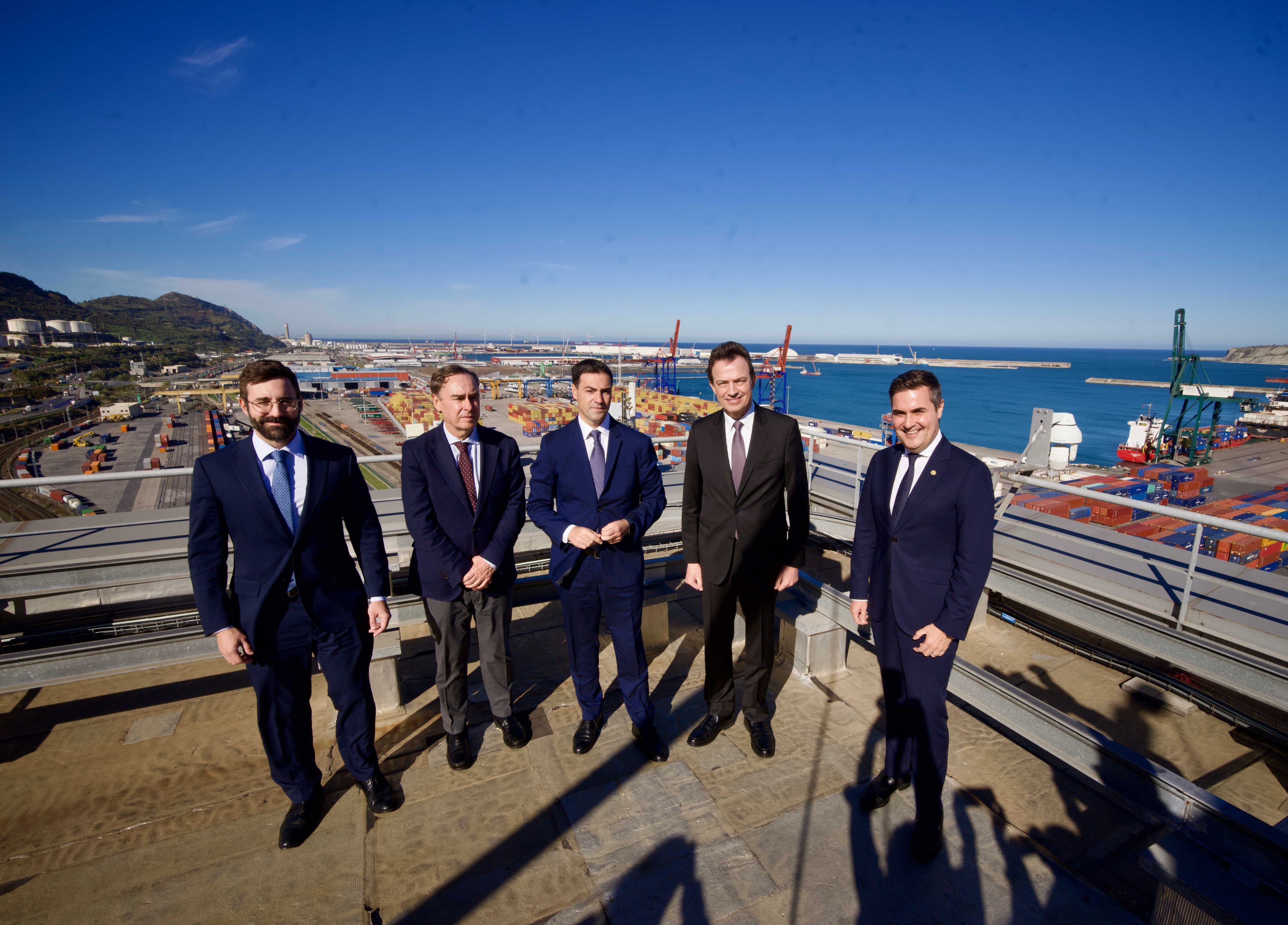Enagás has today launched the Public Consultation Plan (PCP) for the Hydrogen Backbone Network in the Basque Country. The event, held in the Port of Bilbao, was attended by Imanol Pradales, First Minister of the Basque Government; Joan Groizard, Secretary of State for Energy; Mikel Jauregi, Basque Government Minister for Industry, Energy Transition and Sustainability; Arturo Gonzalo, CEO of Enagás; and Antonio Aiz, managing director of the Bilbao Port Authority.
At the event, details were provided on what will be a key project for the sustainable economic development of the Basque Country. Also present at the launch were the mayors and councillors of the different municipalities the network will run through, as well as representatives from the main industrial players and companies of the hydrogen value chain in the Basque Country.
Imanol Pradales, First Minister of the Basque Government, defended the need to decarbonise the Basque economic and development model as quickly as possible without losing competitiveness, given that “our jobs, social cohesion, technological progress, environmental balance and strategic autonomy are all at stake”. During his intervention, Mr Pradales reminded those present that the Basque Country is taking steps to position itself at the forefront of this transformation, stressing that “the development of the hydrogen value chain is a strategic priority for the Basque Country”.
“This project,” he added, “is perfectly aligned with this priority, as it provides for a network of around 163 kilometres of pipelines connecting the main industrial hubs of the Basque Country with hydrogen production centres. Furthermore, the network takes advantage of synergies with existing infrastructure and is complemented by other projects in the offing, such as the one that will connect to the Ayala Valley, or the Bergara-Irún pipeline”. In this regard, the First Minister confirmed the Basque Government’s firm commitment to actively participate in the development of this network through the Basque Energy Agency.
Joan Groizard, Secretary of State for Energy, pointed out that “the Ministry for Ecological Transition and the Demographic Challenge, through IDAE (Institute for Energy Diversification and Saving), has already awarded more than 3 billion euros in grants for the development of renewable hydrogen. This commitment has already seen over 100 projects launched, nine of them in the Basque Country, which are leveraging some 6 billion euros in investment. However, the potential of these projects, both large and small, will only be fully realised when they are interconnected with the hydrogen backbone network, which will act as the backbone of the system. This process would not be possible without the exemplary coordination between the General State Administration, the autonomous regions and Enagás, designated by the Council of Ministers as the operator of the backbone network. And the process of public consultation that we are launching today is an essential part of this journey”.
Mikel Jauregi, Basque Government Minister for Industry, Energy Transition and Sustainability, added that “in the Basque Country, we remain committed to new energy infrastructure and smart decarbonisation, combining lower emission levels with greater competitiveness for our industry. This new infrastructure will enable us to replace gas with green hydrogen to decarbonise our industry and power generation”.
Arturo Gonzalo, CEO of Enagás, highlighted that “the Basque Country is already a key energy and industrial hub in Europe, and its crucial role in the hydrogen backbone network will further strengthen this position. Through the Public Consultation Plan, municipalities, government bodies and Basque society at large will contribute to the development of this infrastructure and to decarbonisation. Green hydrogen will have a very significant economic and social impact in the Basque Country”.
Hub of the Hydrogen Backbone Network
As part of the Cantabrian Coast axis, the Basque Country will have a network of around 163 km of hydrogen pipelines running through the region in two sections: Reocín-Arrigorriaga, stretching for around 38 km, and Arrigorriaga-Haro, around 125 km. The future network will turn the Basque Country into a hub for the hydrogen market, with a potential aggregation node in the vicinity of Bilbao and Vitoria-Gasteiz, where future production and consumption projects are concentrated.
The results of the Call For Interest (presented in 2024) for the first axes of the Hydrogen Backbone Network, which are included in the list of European Projects of Common Interest (PCI), also identify the Basque Country as a relevant area for renewable hydrogen. This infrastructure will contribute to the delivery of the Basque Hydrogen Strategy, which envisages the production of 100,000 tonnes of green hydrogen and up to 300 MW of electrolysis per year by 2030.
The Public Consultation Plan, designed to cover 150 Basque municipalities
The PCP, scheduled to run through to 19 December, provides for information points to be set up in 50 Basque municipalities; 30 in the province of Bizkaia, 7 in Gipuzkoa and 13 in Álava. The selected municipalities in Bizkaia are Muskiz, Zierbena, Santurtzi, Abanto y Ciérvana, Ortuella, Valle de Trápaga-Trapagaran, Galdames, Barakaldo, Güeñes, Alonsotegi, Bilbao, Arrankudiaga-Zollo, Arrigorriaga, Miraballes, Zaratamo, Zeberio, Usansolo, Bedia, Lemoa, Igorre, Amorebieta-Etxano, Dima, Durango, Iurreta, Garai, Izurtza, Abadiño, Berriz, Elorrio and Atxondo. In Gipuzkoa, information points will be set up in Elgeta, Bergara, Oñati, Mondragón, Aretxabaleta, Eskoriatza and Leintz-Gatzaga. Finally, in Álava, the chosen municipalities are Okondo, San Millán, Barrundia, Elburgo, Arratzua-Ubarrundia, Legutio, Zigoitia, Vitoria-Gasteiz, Iruña de Oca, Armiñón, Berantevilla, Zambrana and Labastida. The Plan also provides for public consultation meetings to be held in 18 of these locations.
Consultation open to the public
The Basque Country is hosting what is the largest national plan for public consultation of its kind ever undertaken in Spain, covering a total of 13 autonomous regions and more than 500 municipalities. The plan was launched by Enagás on 25 April.
The PCP on the Spanish Hydrogen Backbone Network is designed to engage with autonomous regions, local councils, more than 50 public authorities and 380 organisations and associations, as well as all members of the general public interested in participating. The Plan is scheduled to be rolled out over 18 months, after which a final report on the outcome of the process will be drawn up.
The objective of the plan is to consult and share information on the future hydrogen network with all stakeholders, to answer queries, to explain the need for the project, to encourage the active participation of communities in the process, to mitigate impacts on the local area and to ensure the most appropriate actions are taken from a social and environmental perspective from an early stage.
The project for the first axes of Spain’s inland hydrogen network consists of laying around 2,600 kilometres of hydrogen pipelines, grouped into 15 sections and 5 axes. The hydrogen economy will generate more than 32 billion euros in GDP in Spain and sustain some 81,000 jobs during the development of the backbone network.
Further information is available at https://www.infraestructurasdehidrogeno.es/

 Port access
Port access